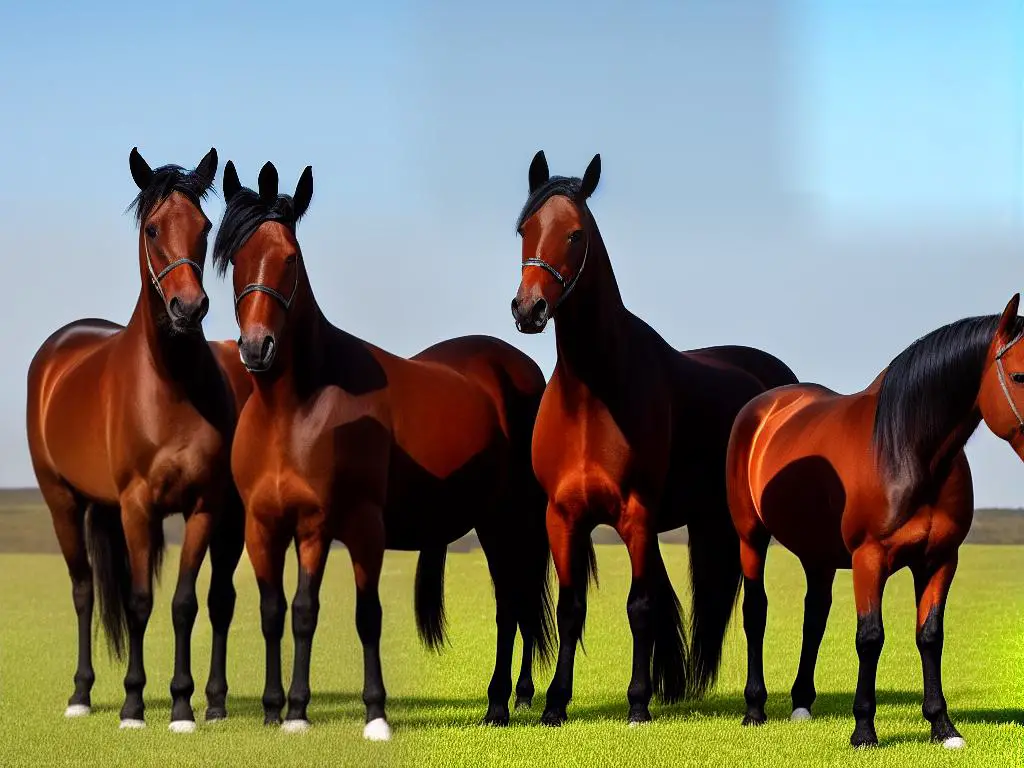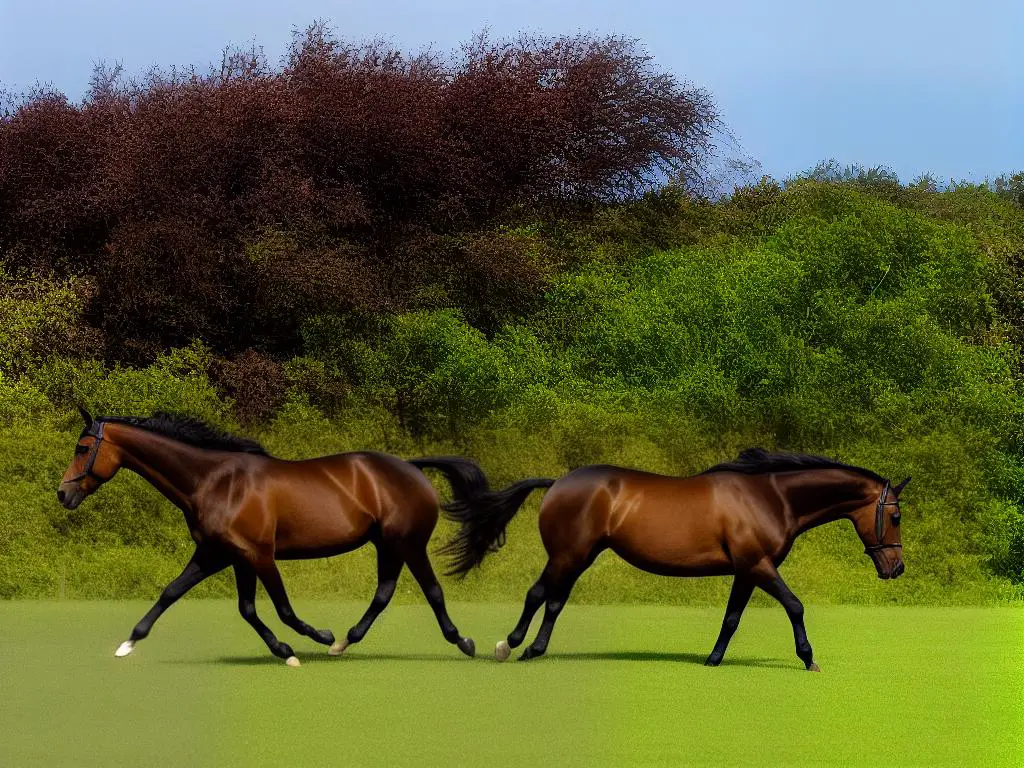There’s a vibrant diversity in the equine world that captivates horse enthusiasts and casual observers alike. Among the hundreds of horse breeds globally, Warmbloods and Thoroughbreds often stand out due to their distinctive characteristics. Understanding these breeds requires delving deeper into their origin, their physical and health attributes, and their comportment in various equestrian disciplines. By exploring their complex histories and idiosyncrasies, we can gain a more informed perspective on what makes these horses truly unique and why a comparison between them can yield intriguing insights.
Table of Contents (Horspedia)
Overview of Warmbloods and Thoroughbreds
Conceptualizing Warmbloods and Thoroughbreds
Warmbloods and Thoroughbreds are two popular categories of horses, each with distinct characteristics, origin stories, general uses in equestrian sports, and breeds. The comparison between these types of horses is pivotal for choosing the most suitable horse breed for specific activities or ensuring the best care for the breed you already own. Understanding these two types of horses will help in making an informed decision based on your needs and preferences, whether it is for equestrian competitions, recreational riding, or breeding purposes.
Defining Warmbloods
As a broad categorization, warmbloods are a group of middle-weight horse types and breeds, typically of European origin. They are characterized by open studbook policies and are bred mainly for equestrian sports. The warmbloods are named as such because they are “warmer” (more spirited and willing) than the “cold-bloods” such as draft horses and calmer than the “hot-bloods” like Thoroughbreds or Arabians.
Some of the well-known warmblood breeds include Hanoverian, Holsteiner, Dutch Warmblood, and Oldenburg among others. These breeds originate from countries like Germany, the Netherlands, and various other locations across Europe. They were initially bred for different needs and over time, selective breeding for equestrian sports has become prevalent.
Warmbloods are reputed for their calm, even temperament, versatility, and endurance. Their athletic build and explosive power make them excellent choices for equestrian sports including dressage, show jumping, and eventing.
Introducing Thoroughbreds
Thoroughbreds, on the other hand, are a specific breed rather than a category — a breed that was selectively developed in England in the 17th and 18th centuries. They are known for their speed, spirit, and endurance, traits that were refined through calculated breeding of mares with three key stallions: The Byerly Turk, The Darley Arabian, and The Godolphin Arabian.
This breed is universally recognized in the horseracing world. Thoroughbreds are most famous for their use in flat racing, but they are also commonly seen in other equestrian sports such as show jumping, dressage, and eventing. Besides, Thoroughbreds are also used in a number of non-competitive activities like recreational riding.
Thoroughbreds are acknowledged for their “hot-blooded” spirit indicating their high energy levels, speed, and agility. They are fine-boned and muscular, usually standing between 15.2 and 17 hands high. Despite their high energy levels, Thoroughbreds can be very gentle and are generally good-natured.
The Importance of Understanding the Distinct Traits of Warmbloods and Thoroughbreds
Identifying the differences between Warmbloods and Thoroughbreds is significant due to each breed’s distinctive characteristics, which render them ideal for certain roles and disciplines within equestrian sports and other horse-related activities. Warmbloods, for example, are renowned for their patience, adaptability, and robustness—attributes that make them popular contenders in dressage and jumping sports where agility, balance, and stamina are crucial. Conversely, the high-energy and speedy Thoroughbreds excel in flat racing and are often chosen for recreational riding.
However, the decision between choosing a warmblood and a thoroughbred isn’t solely dependent on their performance in equestrian sports. Factors such as the horse’s temperament, upkeep requirements, and lifestyle-related parameters—like housing space and training regimes—are also crucial considerations. Discerning the similarities and contrasts between Warmbloods and Thoroughbreds can aid potential horse owners to make well-informed decisions that will cater to their specific needs and preferences. Additionally, this knowledge can influence the appropriate care and training approaches for these breeds.

Physical and Health Differences
Important Factors to Consider when Comparing Warmbloods and Thoroughbreds
When comparing these breeds, it’s imperative to note that each has distinct physical traits, health tendencies, and behavioral patterns. These aspects intrinsically influence a breed’s suitability for various equestrian activities as well as the necessary care and maintenance they require for their well-being.
Physical Differences between Warmbloods and Thoroughbreds
Warmbloods are typically larger than Thoroughbreds, with males often standing between 16 and 17.2 hands (one hand is equivalent to 4 inches), whereas Thoroughbreds usually range from 15.2 to 17 hands. Warmbloods tend to be stockier, with a heavier built and robust bone structure, offering strength and sturdiness. Thoroughbreds tend to be lighter, more slender, with a more delicate bone structure, designed to provide impressive speed and agility.
Another striking difference concerns their muscle structure. Warmbloods have rounded muscles intended to deliver power over extended periods, making them ideal for dressage, jumping, and carriage driving. They possess remarkable stamina and can maintain a steady pace for longer durations. Thoroughbreds, on the other hand, have elongated muscles designed for swift, explosive movement, aptly engineered for racing. They are renowned for their speed and can cover significant distances in a short time.
Coat color also varies between the two. While Warmbloods can come in virtually any color, Thoroughbreds are typically chestnut, bay, black, or grey. Warmbloods also have more variety when it comes to markings and patterns, while Thoroughbreds have fewer variations.
Health Differences and Breed-Specific Conditions
Warmbloods and Thoroughbreds can be susceptible to different health problems due to their unique physiological differences. Warmbloods can have issues like Osteochondrosis Dissecans (OCD), a joint disorder that can cause lameness. Warmblood Fragile Foal Syndrome (WFFS) is a genetic defect that causes foals to be born with extremely fragile skin and other serious health problems.
Thoroughbreds, on the other hand, are often prone to issues such as Exercise-Induced Pulmonary Hemorrhage (EIPH), which can cause bleeding into the lungs during high levels of exercise. They may also develop gastric ulcers more frequently due to the stresses of training and racing. Moreover, they can be victim to lower limb injuries, due to their light bone structure combined with the high-speed activities they often involved in.
Distinctive Behavior Patterns in Each Breed
Even though each horse’s behavior can vary widely based on its upbringing, training, and individual personality, some generalizations can be made about behavior patterns of Warmbloods and Thoroughbreds.
Warmbloods are known for their calm and steady character. They tend to be compliant, easy to train, and perform well under pressure, which makes them suitable for various competitive equestrian disciplines. Thoroughbreds, contrastingly, are often more high-strung and energetic due to their breeding for racing. They can be more challenging to handle for inexperienced riders or handlers but can excel in disciplines requiring speed and agility with the right training and handling.
Concluding Remarks
Ultimately, the decision between a Warmblood and a Thoroughbred depends on your personal preferences and circumstances. As a prospective owner, it’s important to take into account your favorite equestrian disciplines, the physical attributes you desire in a horse, and your capability to handle potential health issues. Prior doing due diligence is imperative, comprised of reviewing medical records, assessing the current health status, and forming realistic expectations about the breed. It’s crucial to remember that each horse, irrespective of its breed, is unique, and there can be substantial variations in character and health condition.

Performance and Temperament Differences
Understanding Warmbloods and Thoroughbreds
Warmbloods and Thoroughbreds are popular horse breeds known for their roles in various equestrian disciplines. Each breed displays unique physical abilities and temperaments, which significantly impacts their performance and appropriateness in different horse sports and activities. Enthusiasts and professionals often assess their capabilities in areas like racing, jumping, and dressage based on these attributes. The subsequent sections will delve into the comparison of these characteristics in both breeds, rounded out by valuable insights from horse owners and trainers.
Thoroughbred Performance in Equestrian Disciplines
Thoroughbreds, particularly those from the United States and England, are renowned for their speed, endurance, and agility. Hence, they’re widely recognized as the ultimate racing horses, positioning them as the dominant breed for flat racing. Their compact bodies and long, lean legs are ideal for generating quick bursts of speed, which makes them ideally suited for the racetrack where speed is paramount.
However, thoroughbreds are not only confined to racing but are also prevalent in other equestrian sports. In eventing and jumping, for instance, they are valued for their speed, bravery, and nimbleness. Moreover, thoroughbreds can be found in dressage. Although dressage is not the breed’s strongest discipline, thoroughbreds with the right confirmation and training can perform well in this area.
Warmblood Performance in Equestrian Disciplines
Warmbloods, on the other hand, are versatile horses known for their strength, balance, and calm demeanor, making them an excellent choice for disciplines which require precision and composure, such as dressage and show jumping. These middle-weight horses possess a structure that is more conducive to power and support instead of utmost speed, with larger bodies and denser bones.
Additionally, warmbloods’ ground-covering stride and preference for a slower, more rhythmic pace lend themselves well to the refined movements of dressage. In show jumping, their strength and equanimity under pressure demonstrate the breed’s suitability for this discipline.
Thoroughbred Temperament
Thoroughbreds are described as hot-blooded, meaning they are highly spirited and have a passionate drive and determination. This temperament can prove advantageous for competitive and strenuous activities where tenacity is an asset, such as racing. They respond well to a confident and gentle handler who can match their energy without intentionally agitating them.
However, some trainers find this breed to be a bit too excitable or anxious, especially in high-stress situations. These horses can become skittish and difficult to handle if not properly trained or if treated aggressively.
Warmblood Temperament
Warmbloods tend to possess a cooler temperament in comparison to Thoroughbreds. They typically exhibit a composed, patient and forgiving nature. This coolheadedness can be a boon in disciplines that require a level of consistency and calm, such as dressage and show jumping.
That being said, their size and strength require handlers with experience and assertiveness to control them. They are less likely to startle compared to hot-blooded breeds, but a lack of assertiveness from the handler can lead to them becoming domineering.
Conclusion
Both Warmbloods and Thoroughbreds are highly valued in the equestrian world, but they each have their own strengths and temperaments that make them suited to different disciplines. Thoroughbreds excel in racing and jumping due to their agility, speed, and competitive drive, while Warmbloods shine in disciplines requiring precision, strength, and composed demeanor, such as dressage and show jumping. Their distinctive temperaments also necessitate different approaches and considerations when handling and training, which should be taken into account by owners or trainers.

Deciphering the true nature of Warmbloods and Thoroughbreds necessitates a comprehensive grasp of their key distinctions and similarities. From the subtle nuances in physical characteristics and health issues to the more noticeable differences in performance and temperament, every aspect reveals the inherent charm and challenges of these breeds. Whether you are an equestrian athlete, a horse trainer, or simply a lover of these magnificent creatures, understanding the intricate details of Warmbloods and Thoroughbreds can significantly enrich your equine experiences and deepen your admiration for these splendid animals.
